spare wheel MERCEDES-BENZ GL-Class 2014 X166 Owner's Manual
[x] Cancel search | Manufacturer: MERCEDES-BENZ, Model Year: 2014, Model line: GL-Class, Model: MERCEDES-BENZ GL-Class 2014 X166Pages: 462, PDF Size: 32.46 MB
Page 12 of 462
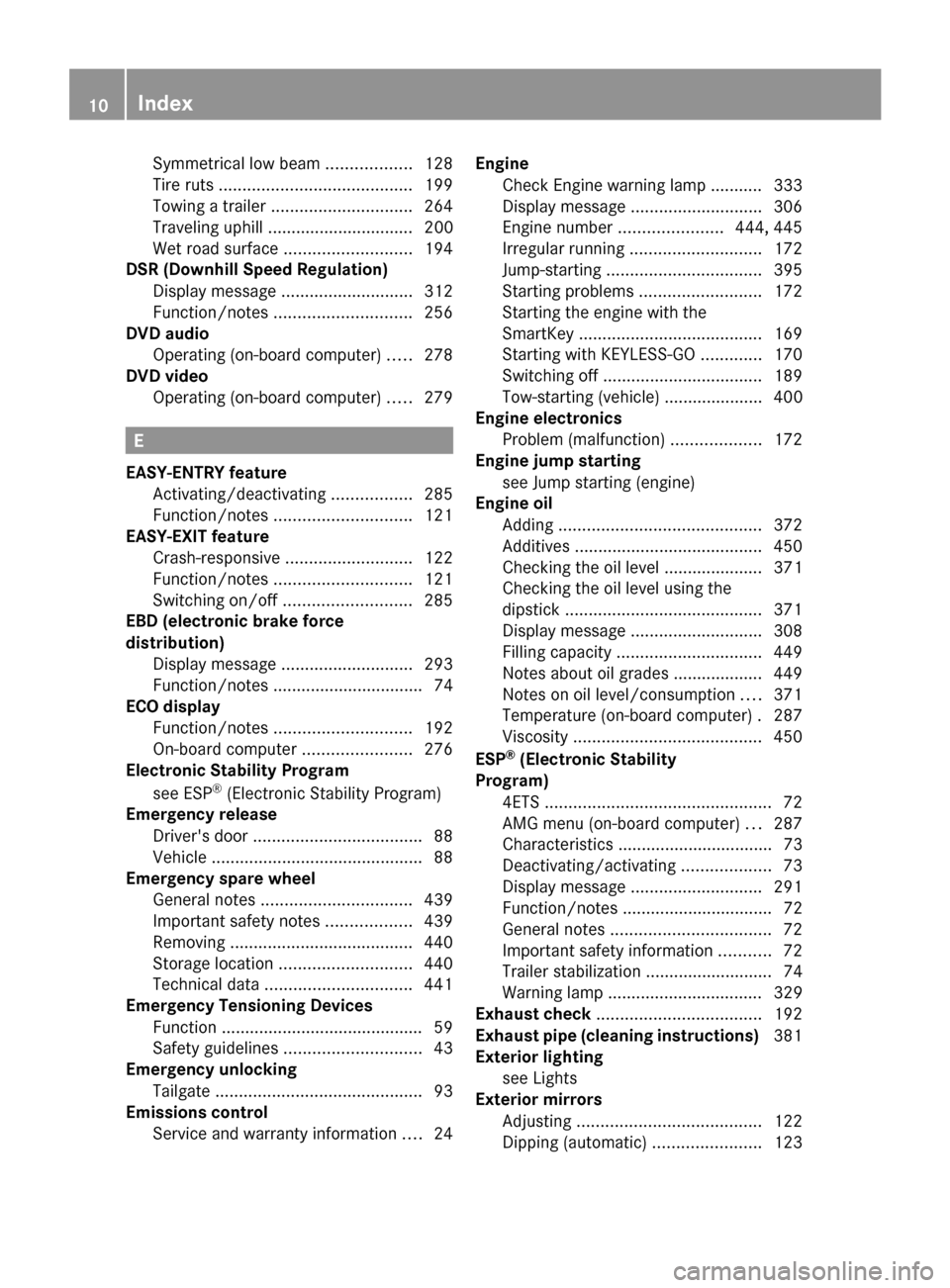
Symmetrical low beam
..................128
Tire ruts ......................................... 199
Towing a trailer .............................. 264
Traveling uphill ............................... 200
Wet road surface ........................... 194
DSR (Downhill Speed Regulation)
Display message ............................ 312
Function/notes ............................. 256
DVD audio
Operating (on-board computer) .....278
DVD video
Operating (on-board computer) .....279 E
EASY-ENTRY feature Activating/deactivating .................285
Function/notes ............................. 121
EASY-EXIT feature
Crash-responsive ........................... 122
Function/notes ............................. 121
Switching on/off ........................... 285
EBD (electronic brake force
distribution)
Display message ............................ 293
Function/notes ................................ 74
ECO display
Function/notes ............................. 192
On-board computer .......................276
Electronic Stability Program
see ESP ®
(Electronic Stability Program)
Emergency release
Driver's door .................................... 88
Vehicle ............................................. 88
Emergency spare wheel
General notes ................................ 439
Important safety notes ..................439
Removing ....................................... 440
Storage location ............................ 440
Technical data ............................... 441
Emergency Tensioning Devices
Function .......................................... .59
Safety guideline s............................. 43
Emergency unlocking
Tailgate ............................................ 93
Emissions control
Service and warranty information ....24 Engine
Check Engine warning lamp ........... 333
Display message ............................ 306
Engine number ...................... 444, 445
Irregular running ............................ 172
Jump-starting ................................. 395
Starting problems ..........................172
Starting the engine with the
SmartKey ....................................... 169
Starting with KEYLESS-GO .............170
Switching off .................................. 189
Tow-starting (vehicle) ..................... 400
Engine electronics
Problem (malfunction) ...................172
Engine jump starting
see Jump starting (engine)
Engine oil
Adding ........................................... 372
Additives ........................................ 450
Checking the oil level ..................... 371
Checking the oil level using the
dipstick .......................................... 371
Display message ............................ 308
Filling capacity ............................... 449
Notes about oil grades ................... 449
Notes on oil level/consumption ....371
Temperature (on-board computer) .287
Viscosity ........................................ 450
ESP ®
(Electronic Stability
Program) 4ETS ................................................ 72
AMG menu (on-board computer) ...287
Characteristics ................................. 73
Deactivating/activating ...................73
Display message ............................ 291
Function/notes ................................ 72
General notes .................................. 72
Important safety information ...........72
Trailer stabilization ........................... 74
Warning lamp ................................. 329
Exhaust check ................................... 192
Exhaust pipe (cleaning instructions) 381
Exterior lighting see Lights
Exterior mirrors
Adjusting ....................................... 122
Dipping (automatic) .......................12310
Index
Page 13 of 462
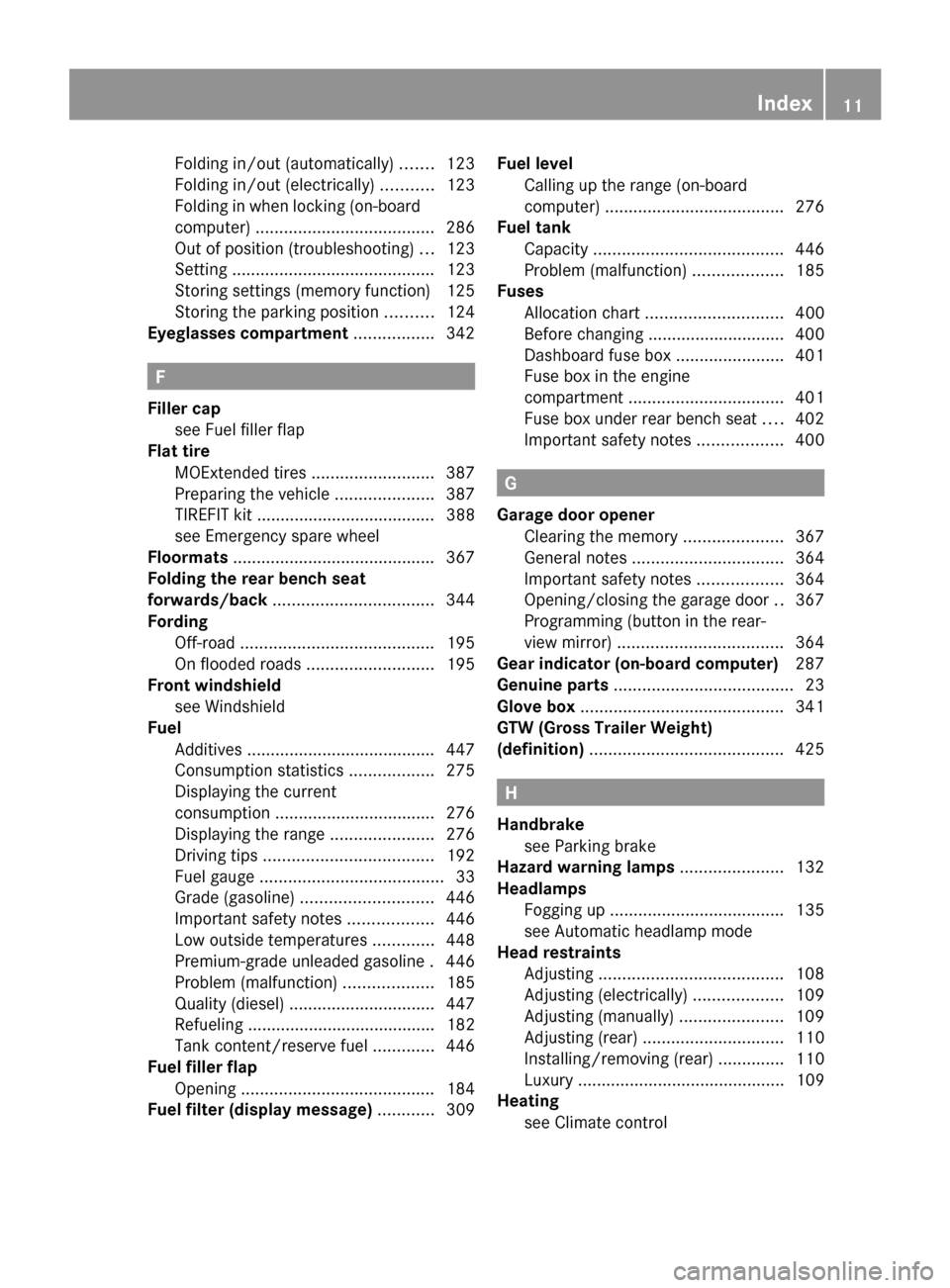
Folding in/out (automatically
)....... 123
Folding in/out (electrically). ..........123
Folding in when locking (on-board
computer) ...................................... 286
Out of position (troubleshooting) ...123
Setting ........................................... 123
Storing settings (memory function) 125
Storing the parking position ..........124
Eyeglasses compartment .................342 F
Filler cap see Fuel filler flap
Flat tire
MOExtended tires ..........................387
Preparing the vehicle .....................387
TIREFIT kit ...................................... 388
see Emergency spare wheel
Floormats ........................................... 367
Folding the rear bench seat
forwards/back .................................. 344
Fording Off-road ......................................... 195
On flooded roads ........................... 195
Front windshield
see Windshield
Fuel
Additives ........................................ 447
Consumption statistics ..................275
Displaying the current
consumption .................................. 276
Displaying the range ......................276
Driving tips .................................... 192
Fuel gauge ....................................... 33
Grade (gasoline) ............................ 446
Important safety notes ..................446
Low outside temperatures .............448
Premium-grade unleaded gasoline .446
Problem (malfunction) ...................185
Quality (diesel )............................... 447
Refueling ........................................ 182
Tank content/reserve fuel .............446
Fuel filler flap
Opening ......................................... 184
Fuel filter (display message) ............309Fuel level
Calling up the range (on-board
computer) ...................................... 276
Fuel tank
Capacity ........................................ 446
Problem (malfunction) ...................185
Fuses
Allocation chart ............................. 400
Before changing ............................. 400
Dashboard fuse box .......................401
Fuse box in the engine
compartment ................................. 401
Fuse box under rear bench seat ....402
Important safety notes ..................400 G
Garage door opener Clearing the memory .....................367
General notes ................................ 364
Important safety notes ..................364
Opening/closing the garage door ..367
Programming (button in the rear-
view mirror) ................................... 364
Gear indicator (on-board computer) 287
Genuine parts ...................................... 23
Glove box ........................................... 341
GTW (Gross Trailer Weight)
(definition) ......................................... 425 H
Handbrake see Parking brake
Hazard warning lamps ......................132
Headlamps Fogging up ..................................... 135
see Automatic headlamp mode
Head restraints
Adjusting ....................................... 108
Adjusting (electrically) ...................109
Adjusting (manually). .....................109
Adjusting (rear) .............................. 110
Installing/removing (rear) ..............110
Luxury ............................................ 109
Heating
see Climate control Index
11
Page 21 of 462
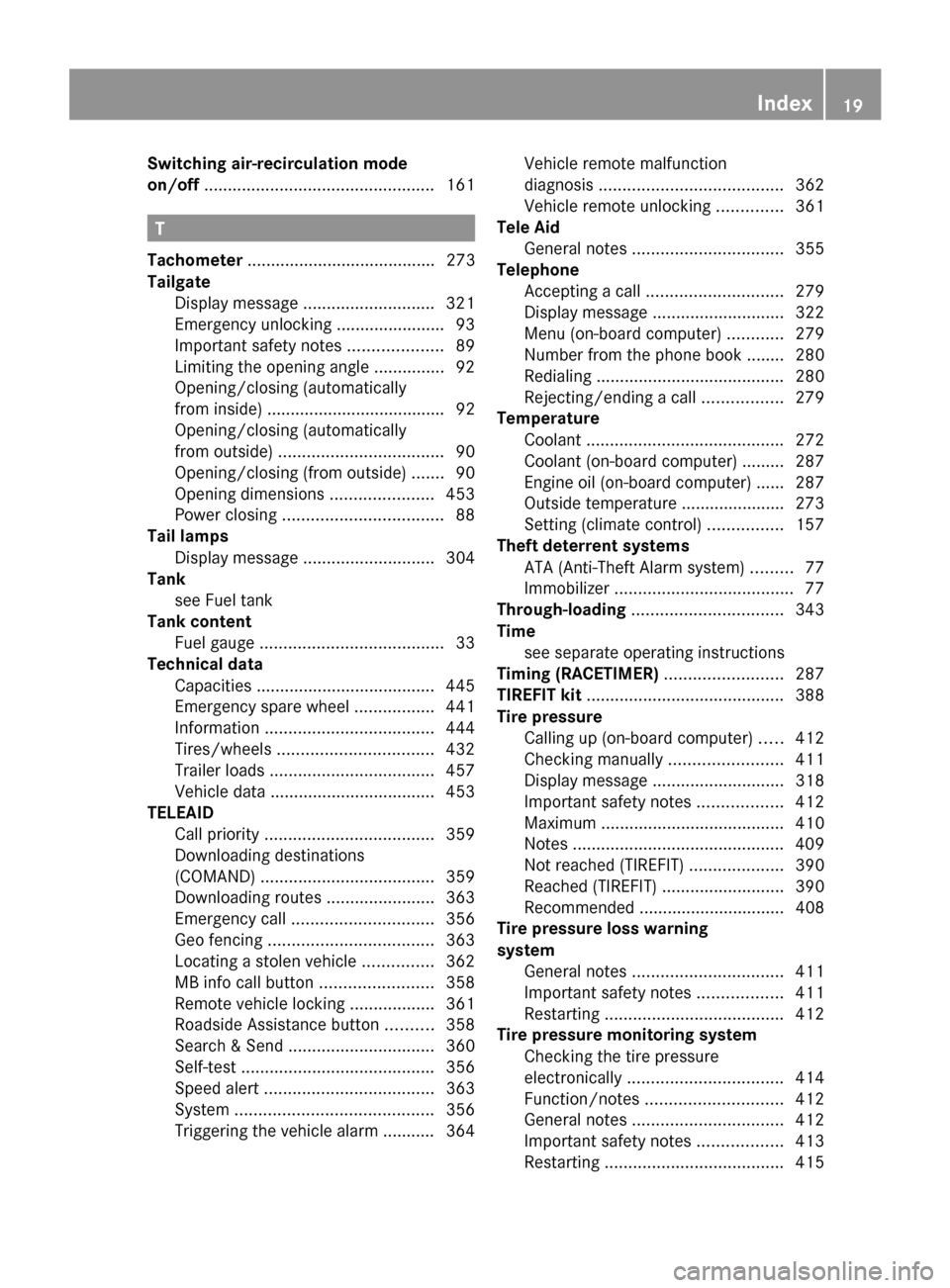
Switching air-recirculation mode
on/off
................................................. 161T
Tachometer ........................................ 273
Tailgate Display message ............................ 321
Emergency unlocking .......................93
Important safety notes ....................89
Limiting the opening angle ...............92
Opening/closing (automatically
from inside) ...................................... 92
Opening/closing (automatically
from outside) ................................... 90
Opening/closing (from outside) .......90
Opening dimensions ......................453
Power closing .................................. 88
Tail lamps
Display message ............................ 304
Tank
see Fuel tank
Tank content
Fuel gauge ....................................... 33
Technical data
Capacities ...................................... 445
Emergency spare wheel .................441
Information .................................... 444
Tires/wheels ................................. 432
Trailer loads ................................... 457
Vehicle data ................................... 453
TELEAID
Call priority .................................... 359
Downloading destinations
(COMAND) ..................................... 359
Downloading routes .......................363
Emergency call .............................. 356
Geo fencing ................................... 363
Locating a stolen vehicle ...............362
MB info call button ........................358
Remote vehicle locking ..................361
Roadside Assistance button ..........358
Search & Send ............................... 360
Self-test ......................................... 356
Speed alert .................................... 363
System .......................................... 356
Triggering the vehicle alarm ........... 364 Vehicle remote malfunction
diagnosis
....................................... 362
Vehicle remote unlocking ..............361
Tele Aid
General notes ................................ 355
Telephone
Accepting a call ............................. 279
Display message ............................ 322
Menu (on-board computer) ............279
Number from the phone book ....... .280
Redialing ........................................ 280
Rejecting/ending a call .................279
Temperature
Coolant .......................................... 272
Coolant (on-board computer) ......... 287
Engine oil (on-board computer) ...... 287
Outside temperature ..................... .273
Setting (climate control) ................157
Theft deterrent systems
ATA (Anti-Theft Alarm system) .........77
Immobilizer ...................................... 77
Through-loading ................................ 343
Time see separate operating instructions
Timing (RACETIMER) .........................287
TIREFIT kit .......................................... 388
Tire pressure Calling up (on-board computer) .....412
Checking manually ........................411
Display message ............................ 318
Important safety notes ..................412
Maximum ....................................... 410
Notes ............................................. 409
Not reached (TIREFIT) ....................390
Reached (TIREFIT) ..........................390
Recommended ............................... 408
Tire pressure loss warning
system General notes ................................ 411
Important safety notes ..................411
Restarting ...................................... 412
Tire pressure monitoring system
Checking the tire pressure
electronically ................................. 414
Function/notes ............................. 412
General notes ................................ 412
Important safety notes ..................413
Restarting ...................................... 415 Index
19
Page 24 of 462
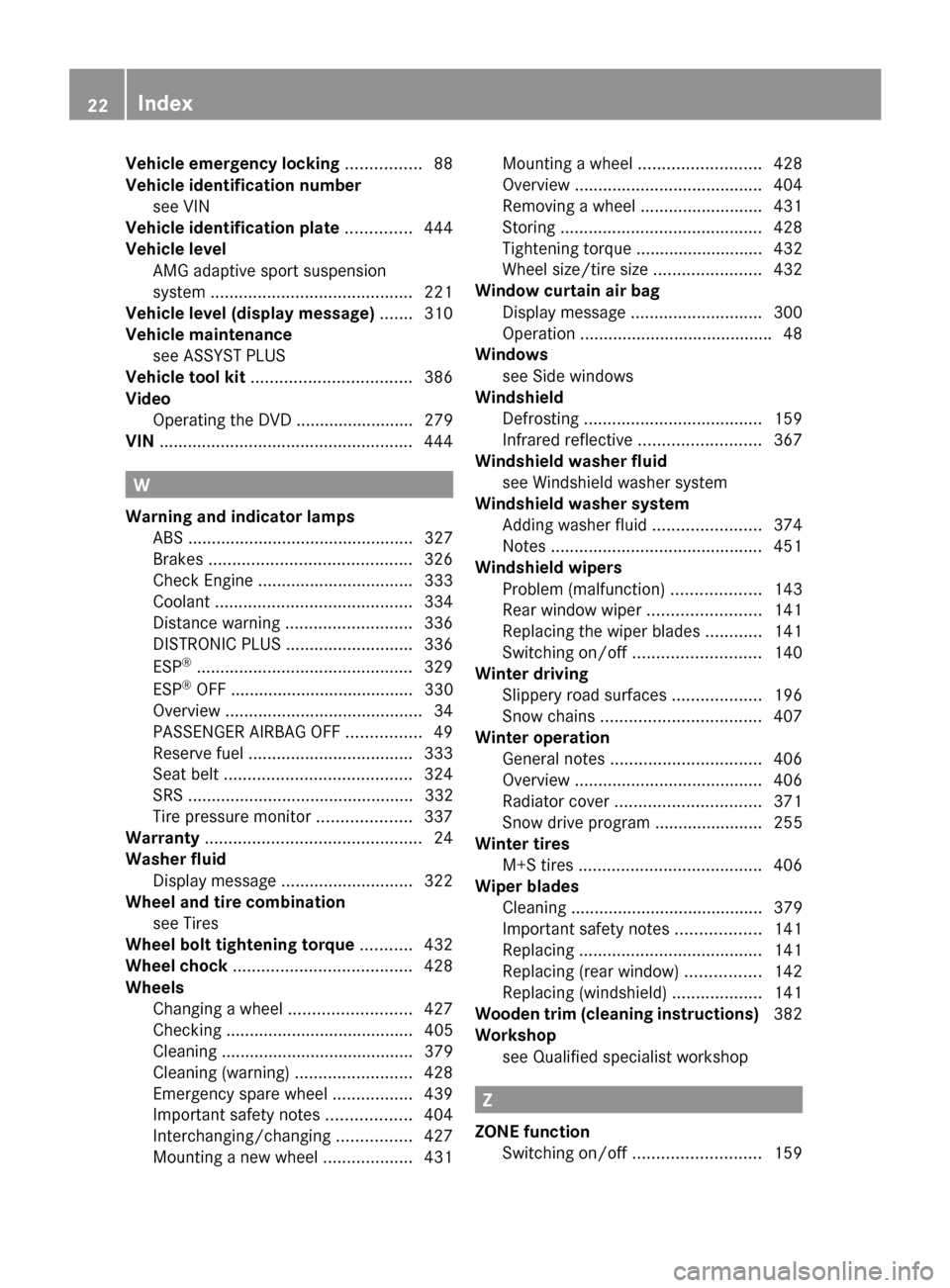
Vehicle emergency locking
................88
Vehicle identification number see VIN
Vehicle identification plate ..............444
Vehicle level AMG adaptive sport suspension
system ........................................... 221
Vehicle level (display message) .......310
Vehicle maintenance see ASSYST PLUS
Vehicle tool kit .................................. 386
Video Operating the DVD ......................... 279
VIN ...................................................... 444W
Warning and indicator lamps ABS ................................................ 327
Brakes ........................................... 326
Check Engine ................................. 333
Coolant .......................................... 334
Distance warning ........................... 336
DISTRONIC PLUS ........................... 336
ESP ®
.............................................. 329
ESP ®
OFF ....................................... 330
Overview .......................................... 34
PASSENGER AIRBAG OFF ................49
Reserve fuel ................................... 333
Seat belt ........................................ 324
SRS ................................................ 332
Tire pressure monitor ....................337
Warranty .............................................. 24
Washer fluid Display message ............................ 322
Wheel and tire combination
see Tires
Wheel bolt tightening torque ...........432
Wheel chock ...................................... 428
Wheels Changing a wheel .......................... 427
Checking ........................................ 405
Cleaning ......................................... 379
Cleaning (warning) .........................428
Emergency spare wheel .................439
Important safety notes ..................404
Interchanging/changing ................427
Mounting a new wheel ...................431Mounting a wheel
.......................... 428
Overview ........................................ 404
Removing a wheel ..........................431
Storing ........................................... 428
Tightening torque ........................... 432
Wheel size/tire size .......................432
Window curtain air bag
Display message ............................ 300
Operation ........................................ .48
Windows
see Side windows
Windshield
Defrosting ...................................... 159
Infrared reflective .......................... 367
Windshield washer fluid
see Windshield washer system
Windshield washer system
Adding washer fluid .......................374
Notes ............................................. 451
Windshield wipers
Problem (malfunction) ...................143
Rear window wiper ........................141
Replacing the wiper blades ............141
Switching on/off ........................... 140
Winter driving
Slippery road surfaces ...................196
Snow chains .................................. 407
Winter operation
General notes ................................ 406
Overview ........................................ 406
Radiator cover ............................... 371
Snow drive program ....................... 255
Winter tires
M+S tires ....................................... 406
Wiper blades
Cleaning ......................................... 379
Important safety notes ..................141
Replacing ....................................... 141
Replacing (rear window) ................142
Replacing (windshield )................... 141
Wooden trim (cleaning instructions) 382
Workshop see Qualified specialist workshop Z
ZONE function Switching on/off ........................... 15922
Index
Page 342 of 462
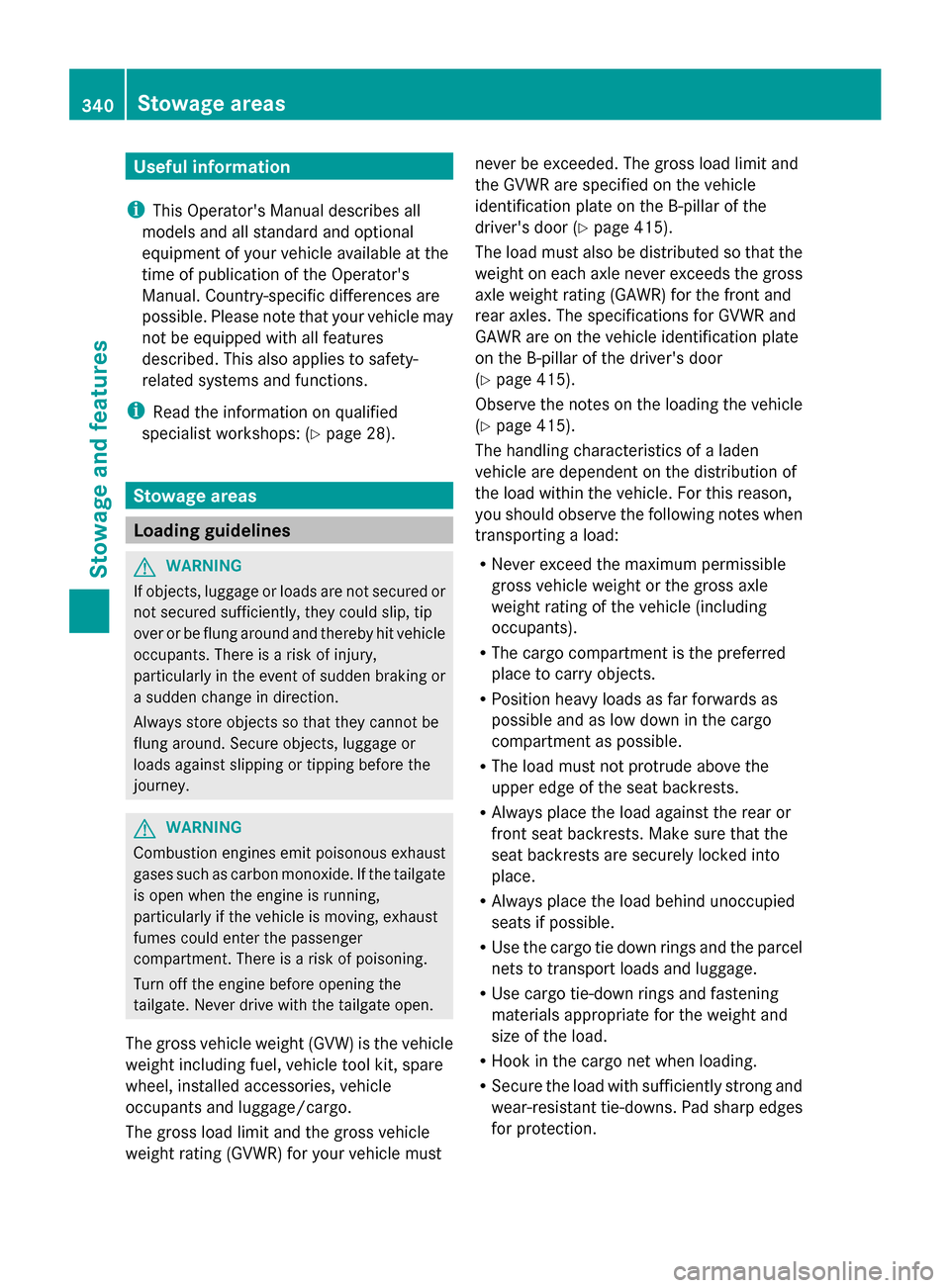
Useful information
i This Operator's Manual describes all
models and all standard and optional
equipment of your vehicle available at the
time of publication of the Operator's
Manual. Country-specific differences are
possible. Please note that your vehicle may
not be equipped with all features
described. This also applies to safety-
related systems and functions.
i Read the information on qualified
specialist workshops: (Y page 28).Stowage areas
Loading guidelines
G
WARNING
If objects, luggage or loads are not secured or
not secured sufficiently, they could slip, tip
over or be flung around and thereby hit vehicle
occupants. There is a risk of injury,
particularly in the event of sudden braking or
a sudden change in direction.
Always store objects so that they cannot be
flung around. Secure objects, luggage or
loads against slipping or tipping before the
journey. G
WARNING
Combustion engines emit poisonous exhaust
gases such as carbon monoxide. If the tailgate
is open when the engine is running,
particularly if the vehicle is moving, exhaust
fumes could enter the passenger
compartment. There is a risk of poisoning.
Turn off the engine before opening the
tailgate. Never drive with the tailgate open.
The gross vehicle weight (GVW) is the vehicle
weight including fuel, vehicle tool kit, spare
wheel, installed accessories, vehicle
occupants and luggage/cargo.
The gross load limit and the gross vehicle
weight rating (GVWR) for your vehicle must never be exceeded. The gross load limit and
the GVWR are specified on the vehicle
identification plate on the B-pillar of the
driver's door (Y
page 415).
The load must also be distributed so that the
weight on each axle never exceeds the gross
axle weight rating (GAWR) for the front and
rear axles. The specifications for GVWR and
GAWR are on the vehicle identification plate
on the B-pillar of the driver's door
(Y page 415).
Observe the notes on the loading the vehicle
(Y page 415).
The handling characteristics of a laden
vehicle are dependent on the distribution of
the load within the vehicle. For this reason,
you should observe the following notes when
transporting a load:
R Never exceed the maximum permissible
gross vehicle weight or the gross axle
weight rating of the vehicle (including
occupants).
R The cargo compartment is the preferred
place to carry objects.
R Position heavy loads as far forwards as
possible and as low down in the cargo
compartment as possible.
R The load must not protrude above the
upper edge of the seat backrests.
R Always place the load against the rear or
front seat backrests. Make sure that the
seat backrests are securely locked into
place.
R Always place the load behind unoccupied
seats if possible.
R Use the cargo tie down rings and the parcel
nets to transport loads and luggage.
R Use cargo tie-down rings and fastening
materials appropriate for the weight and
size of the load.
R Hook in the cargo net when loading.
R Secure the load with sufficiently strong and
wear-resistant tie-downs. Pad sharp edges
for protection. 340
Stowage areasStowage and features
Page 388 of 462
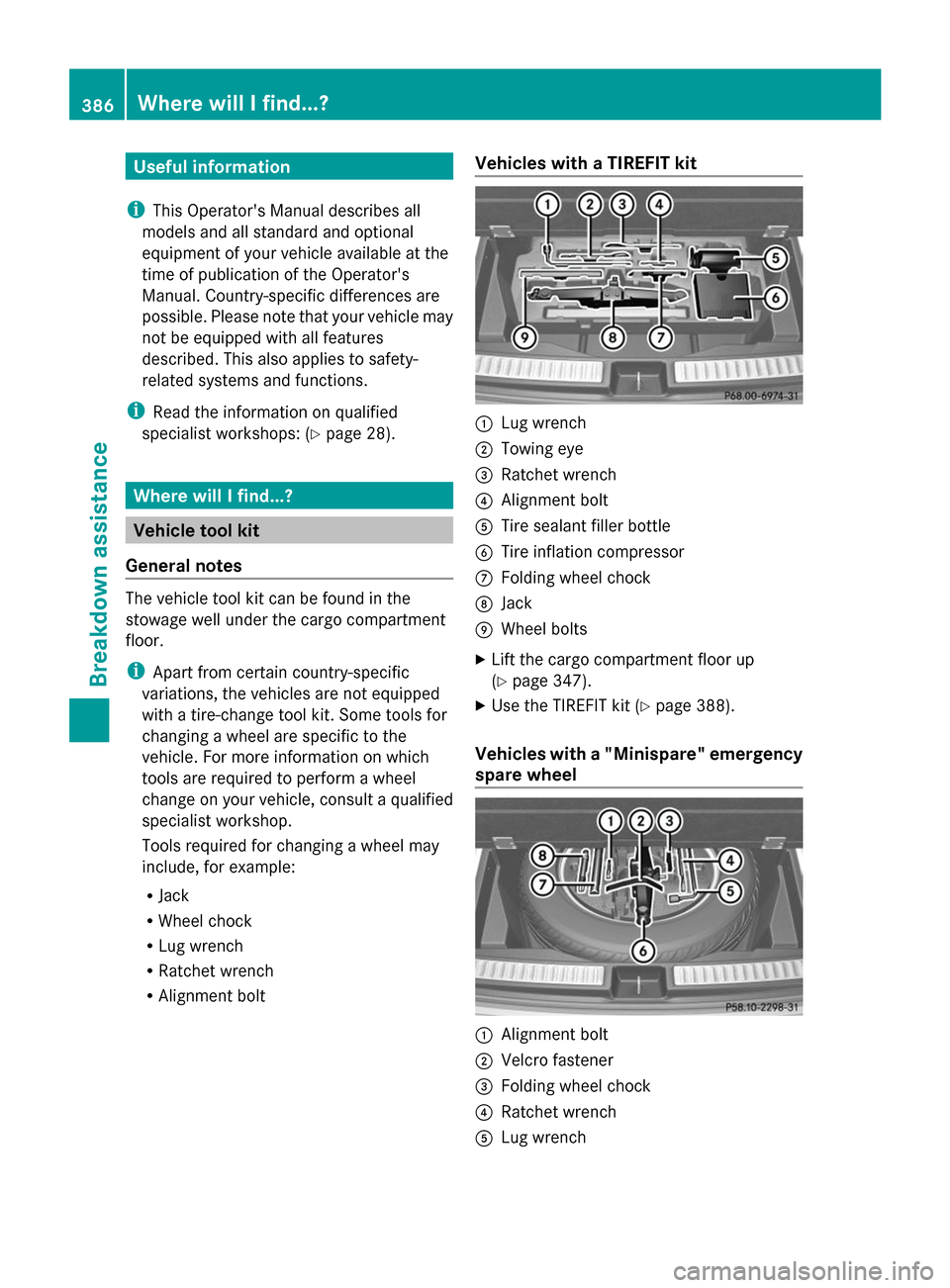
Useful information
i This Operator's Manual describes all
models and all standard and optional
equipment of your vehicle available at the
time of publication of the Operator's
Manual. Country-specific differences are
possible. Please note that your vehicle may
not be equipped with all features
described. This also applies to safety-
related systems and functions.
i Read the information on qualified
specialist workshops: (Y page 28).Where will I find...?
Vehicle tool kit
General notes The vehicle tool kit can be found in the
stowage well under the cargo compartment
floor.
i Apart from certain country-specific
variations, the vehicles are not equipped
with a tire-change tool kit. Some tools for
changing a wheel are specific to the
vehicle. For more information on which
tools are required to perform a wheel
change on your vehicle, consult a qualified
specialist workshop.
Tools required for changing a wheel may
include, for example:
R Jack
R Wheel chock
R Lug wrench
R Ratchet wrench
R Alignment bolt Vehicles with a TIREFIT kit :
Lug wrench
; Towing eye
= Ratchet wrench
? Alignment bolt
A Tire sealant filler bottle
B Tire inflation compressor
C Folding wheel chock
D Jack
E Wheel bolts
X Lift the cargo compartment floor up
(Y page 347).
X Use the TIREFIT kit (Y page 388).
Vehicles with a "Minispare" emergency
spare wheel :
Alignment bolt
; Velcro fastener
= Folding wheel chock
? Ratchet wrench
A Lug wrench 386
Where will I find...?Breakdown assistance
Page 389 of 462
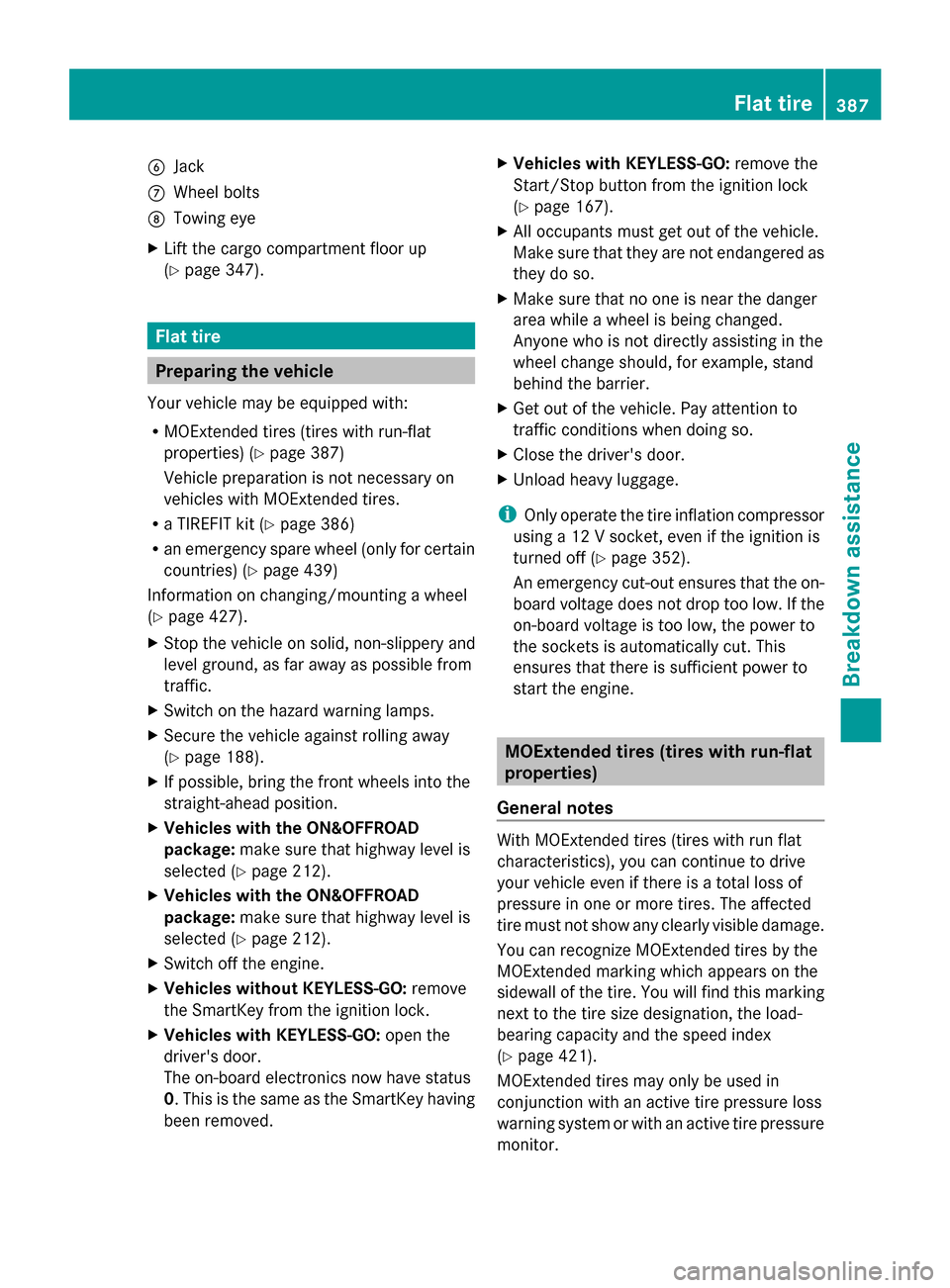
B
Jack
C Wheel bolts
D Towing eye
X Lift the cargo compartment floor up
(Y page 347). Flat tire
Preparing the vehicle
Your vehicle may be equipped with:
R MOExtended tires (tires with run-flat
properties) (Y page 387)
Vehicle preparation is not necessary on
vehicles with MOExtended tires.
R a TIREFIT kit (Y page 386)
R an emergency spare wheel (only for certain
countries) (Y page 439)
Information on changing/mounting a wheel
(Y page 427).
X Stop the vehicle on solid, non-slippery and
level ground, as far away as possible from
traffic.
X Switch on the hazard warning lamps.
X Secure the vehicle against rolling away
(Y page 188).
X If possible, bring the front wheels into the
straight-ahead position.
X Vehicles with the ON&OFFROAD
package: make sure that highway level is
selected (Y page 212).
X Vehicles with the ON&OFFROAD
package: make sure that highway level is
selected (Y page 212).
X Switch off the engine.
X Vehicles without KEYLESS-GO: remove
the SmartKey from the ignition lock.
X Vehicles with KEYLESS-GO: open the
driver's door.
The on-board electronics now have status
0. This is the same as the SmartKey having
been removed. X
Vehicles with KEYLESS-GO: remove the
Start/Stop button from the ignition lock
(Y page 167).
X All occupants must get out of the vehicle.
Make sure that they are not endangered as
they do so.
X Make sure that no one is near the danger
area while a wheel is being changed.
Anyone who is not directly assisting in the
wheel change should, for example, stand
behind the barrier.
X Get out of the vehicle. Pay attention to
traffic conditions when doing so.
X Close the driver's door.
X Unload heavy luggage.
i Only operate the tire inflation compressor
using a 12 V socket, even if the ignition is
turned off (Y page 352).
An emergency cut-out ensures that the on-
board voltage does not drop too low. If the
on-board voltage is too low, the power to
the sockets is automatically cut. This
ensures that there is sufficient power to
start the engine. MOExtended tires (tires with run-flat
properties)
General notes With MOExtended tires (tires with run flat
characteristics), you can continue to drive
your vehicle even if there is a total loss of
pressure in one or more tires. The affected
tire must not show any clearly visible damage.
You can recognize MOExtended tires by the
MOExtended marking which appears on the
sidewall of the tire. You will find this marking
next to the tire size designation, the load-
bearing capacity and the speed index
(Y page 421).
MOExtended tires may only be used in
conjunction with an active tire pressure loss
warning system or with an active tire pressure
monitor. Flat tire
387Breakdown assistance
Page 405 of 462
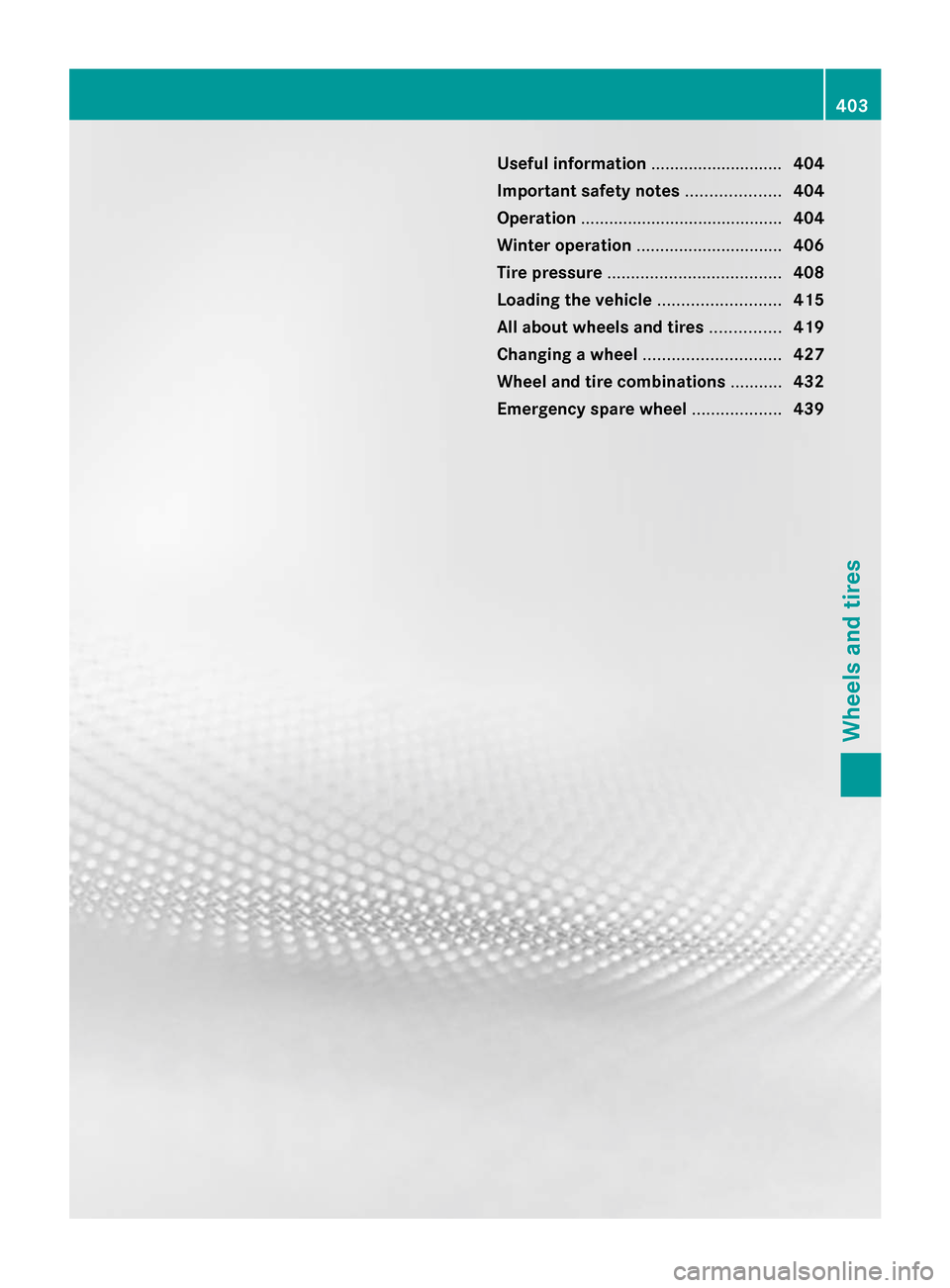
Useful information
............................404
Important safety notes ....................404
Operation ........................................... 404
Winter operation ............................... 406
Tire pressure ..................................... 408
Loading the vehicle ..........................415
All about wheels and tires ...............419
Changing a wheel ............................. 427
Wheel and tire combinations ...........432
Emergency spare wheel ...................439 403Wheels and tires
Page 406 of 462
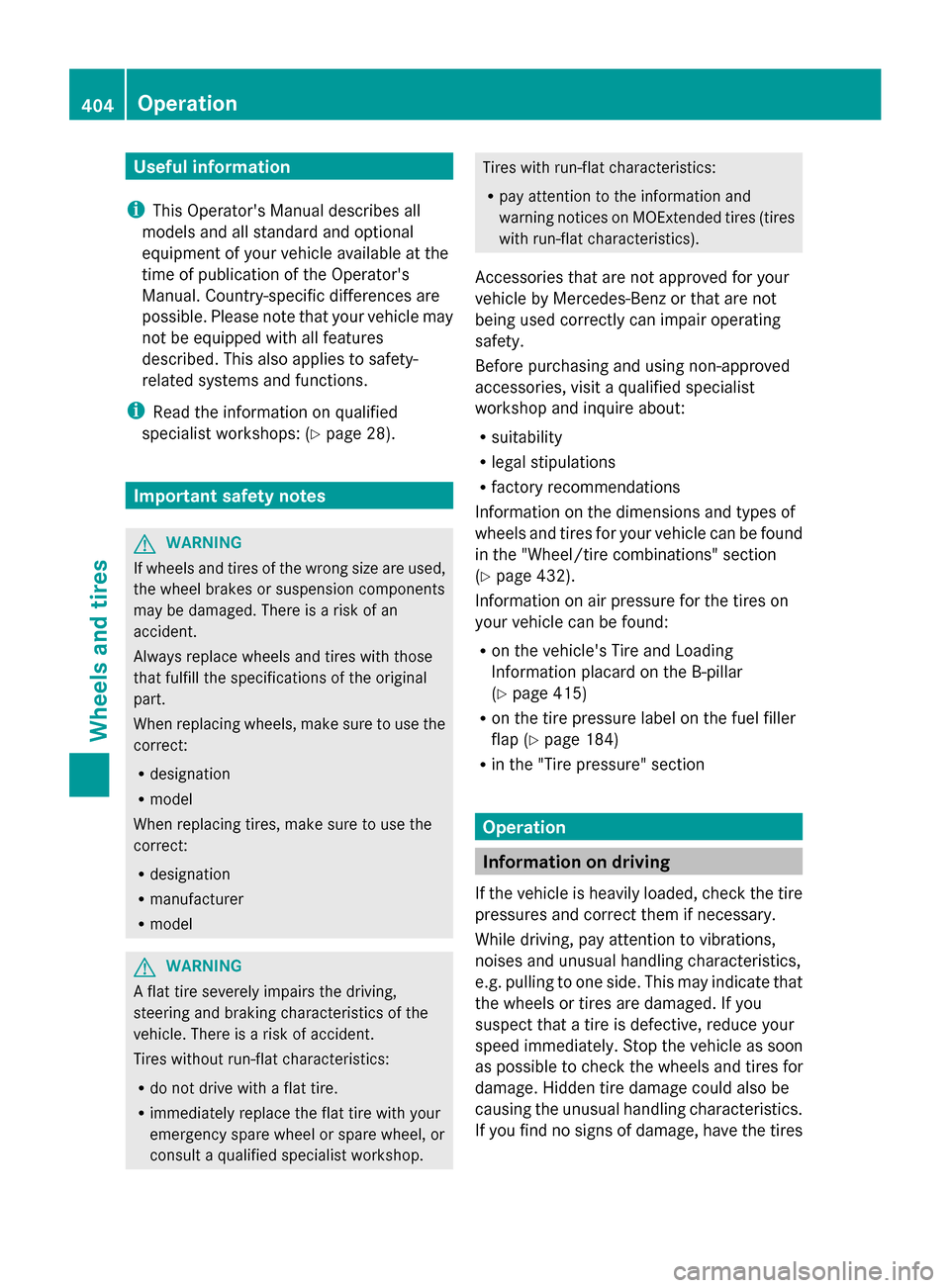
Useful information
i This Operator's Manual describes all
models and all standard and optional
equipment of your vehicle available at the
time of publication of the Operator's
Manual. Country-specific differences are
possible. Please note that your vehicle may
not be equipped with all features
described. This also applies to safety-
related systems and functions.
i Read the information on qualified
specialist workshops: (Y page 28).Important safety notes
G
WARNING
If wheels and tires of the wrong size are used,
the wheel brakes or suspension components
may be damaged. There is a risk of an
accident.
Always replace wheels and tires with those
that fulfill the specifications of the original
part.
When replacing wheels, make sure to use the
correct:
R designation
R model
When replacing tires, make sure to use the
correct:
R designation
R manufacturer
R model G
WARNING
A flat tire severely impairs the driving,
steering and braking characteristics of the
vehicle. There is a risk of accident.
Tires without run-flat characteristics:
R do not drive with a flat tire.
R immediately replace the flat tire with your
emergency spare wheel or spare wheel, or
consult a qualified specialist workshop. Tires with run-flat characteristics:
R
pay attention to the information and
warning notices on MOExtended tires (tires
with run-flat characteristics).
Accessories that are not approved for your
vehicle by Mercedes-Benz or that are not
being used correctly can impair operating
safety.
Before purchasing and using non-approved
accessories, visit a qualified specialist
workshop and inquire about:
R suitability
R legal stipulations
R factory recommendations
Information on the dimensions and types of
wheels and tires for your vehicle can be found
in the "Wheel/tire combinations" section
(Y page 432).
Information on air pressure for the tires on
your vehicle can be found:
R on the vehicle's Tire and Loading
Information placard on the B-pillar
(Y page 415)
R on the tire pressure label on the fuel filler
flap (Y page 184)
R in the "Tire pressure" section Operation
Information on driving
If the vehicle is heavily loaded, check the tire
pressures and correct them if necessary.
While driving, pay attention to vibrations,
noises and unusual handling characteristics,
e.g. pulling to one side. This may indicate that
the wheels or tires are damaged. If you
suspect that a tire is defective, reduce your
speed immediately. Stop the vehicle as soon
as possible to check the wheels and tires for
damage. Hidden tire damage could also be
causing the unusual handling characteristics.
If you find no signs of damage, have the tires 404
OperationWheels and tires
Page 407 of 462
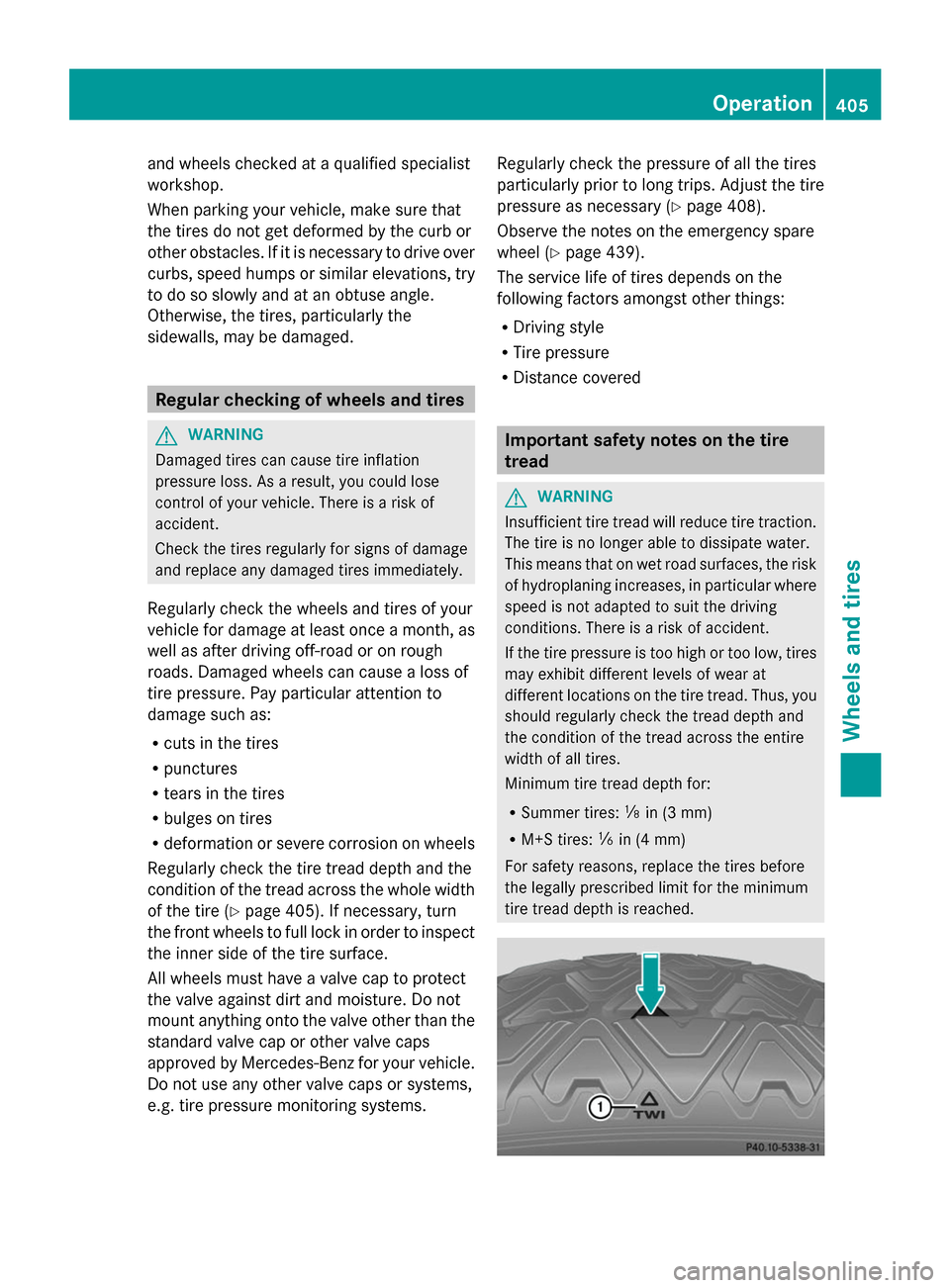
and wheels checked at a qualified specialist
workshop.
When parking your vehicle, make sure that
the tires do not get deformed by the curb or
other obstacles. If it is necessary to drive over
curbs, speed humps or similar elevations, try
to do so slowly and at an obtuse angle.
Otherwise, the tires, particularly the
sidewalls, may be damaged. Regular checking of wheels and tires
G
WARNING
Damaged tires can cause tire inflation
pressure loss. As a result, you could lose
control of your vehicle. There is a risk of
accident.
Check the tires regularly for signs of damage
and replace any damaged tires immediately.
Regularly check the wheels and tires of your
vehicle for damage at least once a month, as
well as after driving off-road or on rough
roads. Damaged wheels can cause a loss of
tire pressure. Pay particular attention to
damage such as:
R cuts in the tires
R punctures
R tears in the tires
R bulges on tires
R deformation or severe corrosion on wheels
Regularly check the tire tread depth and the
condition of the tread across the whole width
of the tire (Y page 405). If necessary, turn
the front wheels to full lock in order to inspect
the inner side of the tire surface.
All wheels must have a valve cap to protect
the valve against dirt and moisture. Do not
mount anything onto the valve other than the
standard valve cap or other valve caps
approved by Mercedes-Benz for your vehicle.
Do not use any other valve caps or systems,
e.g. tire pressure monitoring systems. Regularly check the pressure of all the tires
particularly prior to long trips. Adjust the tire
pressure as necessary (Y
page 408).
Observe the notes on the emergency spare
wheel (Y page 439).
The service life of tires depends on the
following factors amongst other things:
R Driving style
R Tire pressure
R Distance covered Important safety notes on the tire
tread
G
WARNING
Insufficient tire tread will reduce tire traction.
The tire is no longer able to dissipate water.
This means that on wet road surfaces, the risk
of hydroplaning increases, in particular where
speed is not adapted to suit the driving
conditions. There is a risk of accident.
If the tire pressure is too high or too low, tires
may exhibit different levels of wear at
different locations on the tire tread. Thus, you
should regularly check the tread depth and
the condition of the tread across the entire
width of all tires.
Minimum tire tread depth for:
R Summer tires: âin (3 mm)
R M+S tires: ãin (4 mm)
For safety reasons, replace the tires before
the legally prescribed limit for the minimum
tire tread depth is reached. Operation
405Wheels and tires Z